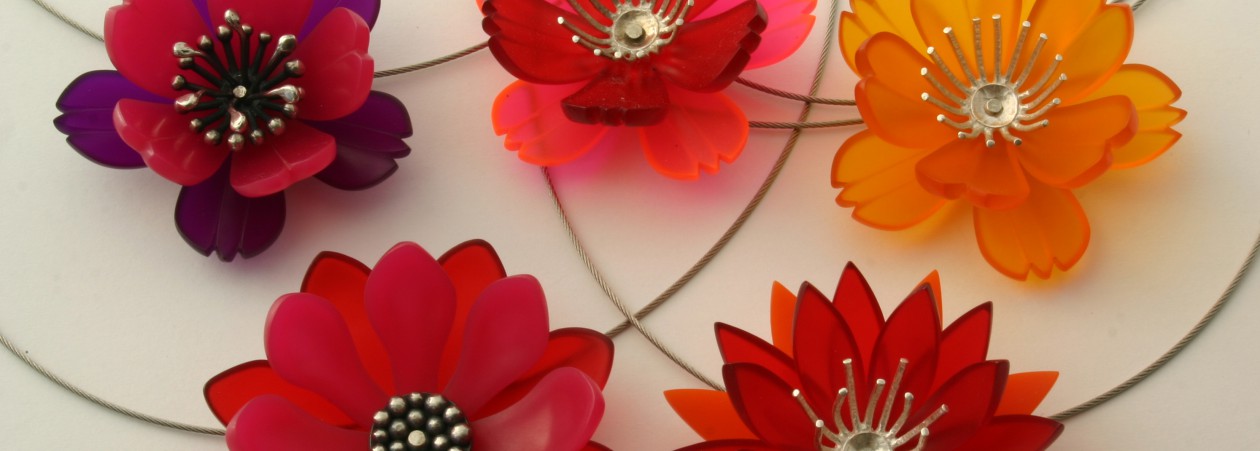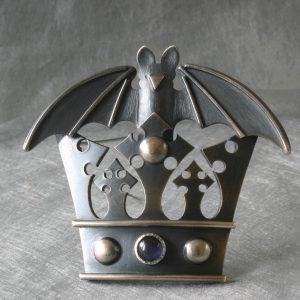Scholarship is divided, as always, on the origin of the Bat and Crown as the heraldry of the Kings of Aragon. After extensive research I attributed the presence of the humble order of chiroptera on the Aragonese coat of arms to King Jaume I the Conquerer 1208- 1276.
Bat & Crown Heraldic Brooch, silver/iolite
Jaume I played a pivotal part in the Reconquista on the Iberian Peninsula. He expanded the House of Aragon north to Languedoc, located in what is now the South of France, south to the Balearic Islands, and southwest to Valencia. He was a handsome virile man, unlike so many of his royal European counterparts, and had three wives and many mistresses, all of whom bore him many children. This eventually led to fratricidal conflict as he tried to be fair in inheritance to all of his sons, rather than just favouring the eldest as he should have done in order to ensure the untroubled continuation of the Kingdom. However, enough of Jaume’s confusing personal life…
Legend has it that Jaume was awoken early on the morning of the decisive battle for Valencia by a bat fluttering around inside his tent. I find it more likely that this compulsive wencher was awoken early by the feminine wiles of a young camp follower than a local variety of murcielago.
An excerpt from Jaume’s writings about the reconquest of Valencia in Llibre del Fets, or his Book of Deeds did reveal this, however:
“At another time the men of the Archbishop of Narbonne were skirmishing with those from inside, but the Archbishop’s men did not know the way of the Saracens, who on that occasion, as in others, fled from them to draw them nearer to the town. Perceiving that the enemy’s footmen were only retreating with that end, I sent my people a message not to pursue, or else the Saracens would do them great hurt.
They would not stay for my message; but I, fearing lest thirty or more of them should be killed by the Moors, went up to them on the same horse I was then riding, and made them draw back. As I was coming with the men, I perceived of a great fluttering above my standard, and happened to turn my head upwards in order to ascertain the cause. To my astonishment I saw a great black bat above it, and took it as a sign from God. At that very moment a Saracen cross-bowman shot at me, and hit me beside the sun-hood, and the shot struck me on the head, the bolt lighting near the forehead. It was God’s will it did not pass through the head, but the point of the arrow went half through it. In anger I struck the arrow so with my hand that I broke it: the blood came out down my face; I wiped it off with a mantle of “sendal” I had, and went away laughing, that the army might not take alarm. I then went and lay down in a tent, when all my face and eyes swelled, so that I could not see for the swelling of the eye on the wounded side. When the swelling in my face had gone down, I rode round the camp that the army might not be discouraged.”
I believe the latter tale to be more likely, because his body was exhumed in 1856 from it’s burial site in the Monastery of Poblet in Catalonia when some restoration work was urgently required, and photos of his mummified head clearly show a healed wound in the bone above his left eyebrow, exactly as described in his writings.
We can assume that something was looking out for Jaume the Conquerer, but maybe it wasn’t the ‘God’ he imagined. However, the symbolism of the incident evidently had a significant impact on him, and the bat was adopted to sit atop the Crown of Aragon. The image of the Bat and Crown can be seen extensively to this day all over Valencia, adorning all the civic buildings, and even the metal utilities covers in the footpaths.

